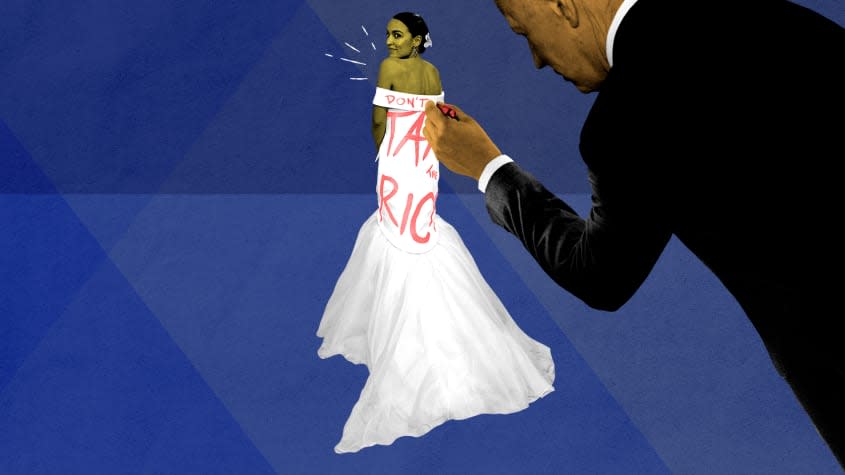Democratic tax plan is a reckoning for the left

Back in June 2019, candidate Joe Biden told wealthy donors at a New York City fundraiser that "nothing would fundamentally change" in their lives if he were elected. Now that Biden sits in the Oval Office, that remark is appearing more prescient by the day, surely to the dismay of progressive Democrats. The House Ways and Means Committee on Wednesday passed a plan to fund Biden's $3.5 trillion social spending plan. Does it substantially increase taxes? It sure does, by $2.1 trillion over a decade. Yet it also doesn't appear to "fundamentally change" the lives of America's superrich.
Indeed, the Ways and Means plan takes a huge step back from many of the big tax hikes originally floated by Biden. Although the plan would increase the top personal income tax rate to 39.6 percent from the current 37 percent and add a 3 percent surtax to incomes over $5 million, it would raise the capital gains tax rate only to 25 percent from 20 percent. Biden would prefer labor and investment income taxed at the same nearly 40 percent rate. Nor does the plan call for the taxation of unrealized capital gains over $1 million at death, which the Biden White House supports. It also would also only limit the preferential tax treatment of "carried interest" — a major source of income for private equity fund managers — rather than eliminate it entirely. "Frankly this is a humiliating climbdown from the administration's posture," James Lucier, an analyst at Capital Alpha Partners in Washington, told The Financial Times. "This avoids most of the stuff that Wall Street is worried about." And one wealth planner tweeted that the changes were "FANTASTIC for the uber-wealthy."
Who knows what Biden's real expectations were, given those 2019 comments to his donors and, just as importantly, such narrow Democratic control of the House and Senate. At least he can tell his progressive allies that he tried for a more substantial attack on American income and wealth inequality. Then again, many Wall Street analysts are expecting this reduced tax hike package to shrink even further.
None of this bodes well, however, for progressive dreams of turning America into a full-fledged, Scandinavian-style social democracy, one with single-payer health care, expansive paid leave, and generous child-care and preschool. Well, all that plus massive spending on a Green New Deal that might include a jobs-for-all guarantee. This week's retreat from the original Biden tax plan suggests just how far America is from funding such an expansive vision.
And even the original Biden plan didn't really get close to Scandinavian levels of taxation. Under that more onerous plan, tax revenue would total 19.3 percent of GDP over the coming decade, according to the Committee for a Responsible Federal Budget. That represents a considerable step-up from the long-term average of 17.3 percent of GDP. But America would still look like a low-tax nation compared to Scandinavia. The Tax Foundation points out that in 2019, Denmark's tax-to-GDP ratio was at 46.3 percent, Norway's at 39.9 percent, and Sweden's at 42.8 percent.
It's hard to look at those Nordic numbers and think that America is anywhere near ready to accept the level of taxation necessary to fund the sort of massive welfare state desired by politicians like Bernie Sanders and Alexandria Ocasio-Cortez. Moreover, those nations achieve those high tax revenue levels via a "value-added" tax, a kind of sales tax. All three Scandinavian nations have a 25 percent VAT, with Denmark collecting about 9.4 percent of GDP through the VAT, Norway 8.6 percent, and Sweden 9.2 percent. But it's a current staple of Democratic tax policy not to raise taxes on the middle class, or families who make less than $400,000 a year.
Starker inequality in the U.S. than Scandinavia might give policymakers more room to increase the tax burden on the rich. Plenty of economists, however, would warn against trying to raise all the needed revenue purely through higher taxes on rich people and companies. As it is, plans to raise the U.S. corporate tax rate to 26.5 percent would give the US the third-highest rate among rich nations. There remains a fundamental mismatch between the spending dreams of the left and the political realities of taxation, as demonstrated by the Ways and Means plan.
Unless of course, Democrats adopt novel theories of macroeconomic policy that suggest significantly less need to pay for government spending. But there's little evidence that anyone outside deeply left progressive politics or EconTwitter takes such ideas seriously. Certainly there's no evidence that Federal Reserve Chairman Jerome Powell does, and he's likely to be renominated for another term as boss of the central bank. If the far left really wants a transformational presidency — whether Biden's or someone else's — the lives of all Americans would need to fundamentally change.
You may also like
Emmys host Cedric the Entertainer has been hoping 'not to get canceled' before the show

 Yahoo Finance
Yahoo Finance 